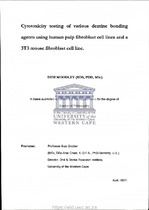| dc.description.abstract | Introduction: Biocompatibility of all kinds of dental materials is of paramount importance In order to prevent/limit irritation or degeneration of the surrounding tissues where it is applied. Some researchers suggested that dentine bonding agents may be used for pulpal protection, while pulpal inflammation and inhibition of pulpal repair following the use of dentine bonding agents were also reported. Objectives: The first part of this study compared the cytotoxicity of human pulp cell lines to a mouse 3T3 cell line to cytotoxic challenges from dentine bonding agents. The second part of the study compared the cytotoxicity of recent dentine bonding agents namely, Scotchbond 1, Prime & Bond NTand Xeno III through artificial membranes as well as thin dentine discs (after its reaction with apatite) and Clearfil Protect Bond (CPB)as such, as well as the primer part of CPBand the bond part of CPB separately. Methods and Materials: Near confluent human pulp
cells and 3T3 cells were exposed to culture medium (DMEM)extractions from the various polymerized agents mentioned above and the cell
viability (survival rate) was measured using the standard MTTassay and related to the non-exposed controls. Results: Two human pulp cells lines were more sensitive to 3T3 cell lines while the other human cell line was less sensitive to the 3T3 cell line. All bonding agents as such were found to be cytotoxic towards the 3T3 cells with Xeno III (25%survival rate) and CPB (35%)the most cytotoxic. Of the two parts from CPB the bond part was the least toxic (91% survival rate), but the primer part (containing the anti-bacterial pyridinium molecule) was very toxic (30% survival rate). ScotchBond 1 (59% survival rate) and Prime & Bond NT (62% survival rate) were not statistically different (Kruskal-Wallis Test, p>0.05). However,the survival rate of Xeno III (25% through membrane as well as dentine discs) and Clearfil Protect Bond (35%) were significantly lower than that of the other two bonding agents, with Xeno III significantly the most toxic (p<0.05 ) Conclusion: In general, all 4 dentine bonding agents were cytotoxic of which Xeno III was the most toxic even after its reaction with apatite (through dentine discs). The most toxic part of CPB was found to be the primer part containing the pyridinium linked molecule. If human pulp fibroblasts are used for
cytotoxicity testing of dentine bonding agents many cell lines must be used. | en_US |

